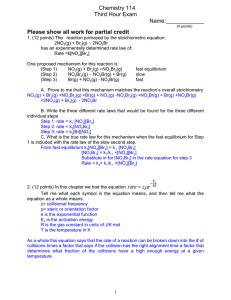The universal gas constant, R, is 8.31 J / Kmol or 0.0821 Latm / Kmol
advertisement
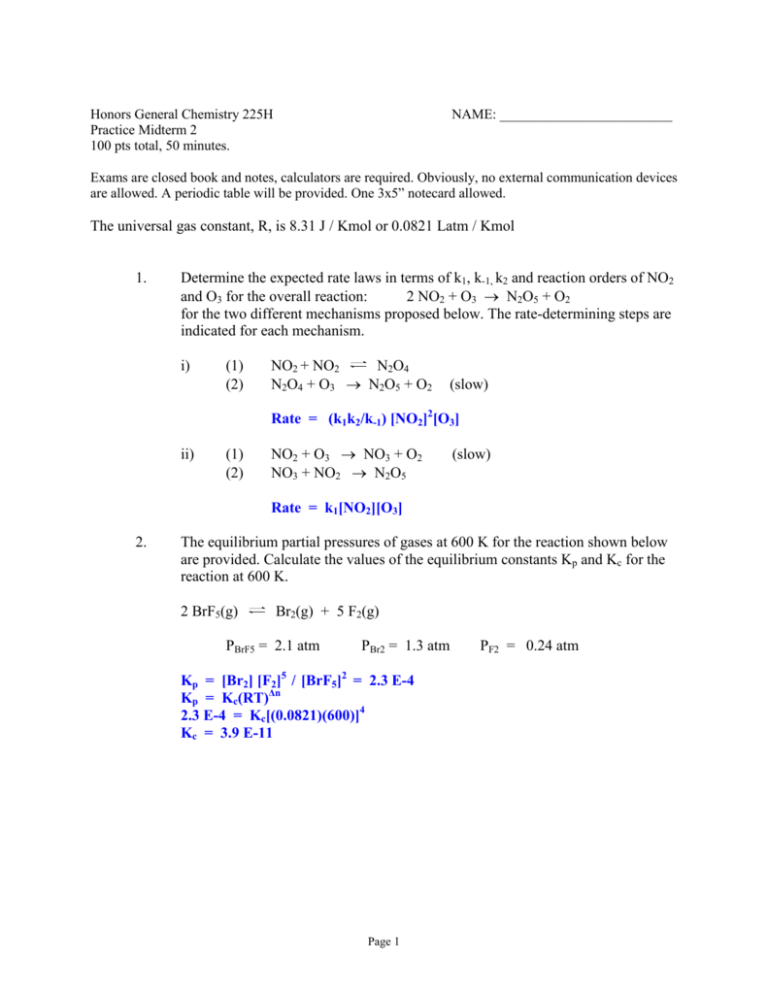
Honors General Chemistry 225H Practice Midterm 2 100 pts total, 50 minutes. NAME: _________________________ Exams are closed book and notes, calculators are required. Obviously, no external communication devices are allowed. A periodic table will be provided. One 3x5” notecard allowed. The universal gas constant, R, is 8.31 J / Kmol or 0.0821 Latm / Kmol 1. Determine the expected rate laws in terms of k1, k-1, k2 and reaction orders of NO2 and O3 for the overall reaction: 2 NO2 + O3 N2O5 + O2 for the two different mechanisms proposed below. The rate-determining steps are indicated for each mechanism. i) (1) (2) NO2 + NO2 N2O4 N2O4 + O3 N2O5 + O2 (slow) Rate = (k1k2/k-1) [NO2]2[O3] ii) (1) (2) NO2 + O3 NO3 + O2 NO3 + NO2 N2O5 (slow) Rate = k1[NO2][O3] 2. The equilibrium partial pressures of gases at 600 K for the reaction shown below are provided. Calculate the values of the equilibrium constants Kp and Kc for the reaction at 600 K. 2 BrF5(g) Br2(g) + 5 F2(g) PBrF5 = 2.1 atm PBr2 = 1.3 atm Kp = [Br2] [F2]5 / [BrF5]2 = 2.3 E-4 Kp = Kc(RT)Δn 2.3 E-4 = Kc[(0.0821)(600)]4 Kc = 3.9 E-11 Page 1 PF2 = 0.24 atm 3. For the equilibrium established in Q2 at 600K, which way (left, right or none) does the equilibrium shift if a gas sample is containing 1.0 atm of BrF5(g) and 1. 0 atm of Br2(g) are injected into the container? In this case, the initial condition becomes: PBrF5 = 3.1, PBr2 = 2.3, and PF2 = 0.24 atm. The reaction quotient, Q = [Br2] [F2]5 / [BrF5]2 = (2.3)(0.24)5/(3.1)2 = 1.9E-4 Since Q<K, the equilibrium shifts to the right. 4. Under an O2(g) pressure of 1.0 atm, 0.037 g of O2(g) dissolves in 1.0 L H2O at 298 K. What is the molarity of O2 in a saturated solution at 298 K under 4.9 atm of O2(g)? (Assume the solution volume is always 1.0 L; molar mass O2 = 32.0 g/mol) [O2] = 0.0057 M 5. Circle the change(s) that will cause the equilibrium NOBr concentration to increase in the following equilibrium: 2 NO(g) + Br2(g) 2 NOBr(g) (Hrxn = - 30 kJ / mol) decrease the temperature Selectively remove some NO (g) Increase the volume containing the gas mixture Add a catalyst 6. Experiments show that the rate of disappearance of cyclopropane according to: cyclopropane propene is first order with a rate constant of 6.2 10–4 min–1 at 700 K. What is the half-life for this reaction? t1/2 = ln 2 / k = 0.693 / 6.2E-4 min-1 = 1100 min 7. For A + B C Kc = 4.2 x 103 at 20 °C Calculate Kc at 20 °C for the equilibrium: C B+A K = 1 / Kc = 1 / 4.2E3 = 2.4 x 10-4 8. Calculate the freezing point of a solution made from 22.0 g of octane (a non-electrolyte with mw = 114 g / mol) in 148.0 g of benzene. Benzene freezes at 5.50C and has Kf = 5.12 °C / m. Page 2 ∆Tf = Tsolvent - Tsolution = Kf m m = mol octane / kg solution = 22 g / (114 g/mol) (0.148 kg) = 1.30 m 5.50 °C - Tsolution = (5.12 °C / m) (1.30) = 6.66 °C Tsolution = – 1.18 °C 9. Explain briefly what the Haber process is, and why it is important. The Haber process involves the formation of ammonia from N2 and H2 using a heterogeneous catalyst at elevated temperature and pressure. The catalyst is complex, but is based on iron metal. This is still today the only large-scale synthetic method for “fixing” N2, and is therefore the ultimate source for the nitrogen in synthetic compounds. Important classes of compounds with nitrogen are fertilizers, explosives, and plastics. 10. The equilibrium constant, Kc = 5.0 for the reaction: SO2(g) + NO2(g) SO3(g) + NO(g) at 1000C. If 1.0 mole of SO2 and 1.0 moles of NO2 are placed in a 2.0 L container, what concentration of SO3 will be present at equilibrium at 1000 °C? Compound SO2 NO2 SO3 NO Initial conc 0.50 M 0.50 M 0 0 change -x -x +x +x equilibrium conc 0.50 - x 0.50 – x x x Kc = 5.0 = [SO3] [NO] / [SO2] [NO2] = x2 / (0.50 – x)2 Taking square roots of both sides: 2.236 = x / (0.50 - x) 1.118 – 1.118x = x x = 1.118 / 2.118 = 0.528 [SO3]equ = 0.53 11. Sketch the potential energy diagram for a two step exothermic reaction, where the first step is rate determining. Indicate the activation energies for mechanistic steps, the position of transition and intermediate states. See Fig. 14-14 in the text Page 3

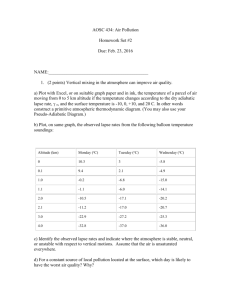

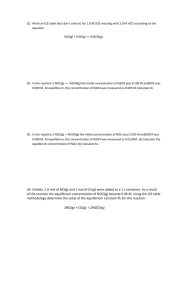

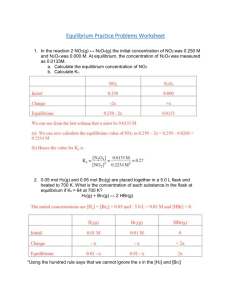
![CHEM 1520 SI MON, TUES, & WEDNES 1.Calculate [H3O+] in a](http://s3.studylib.net/store/data/007346334_1-b78d73402f58153c92290299886ff084-300x300.png)

